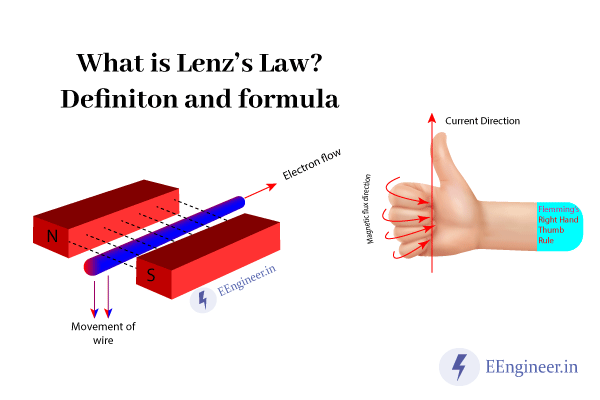Table of Contents
What is Lenz’s law?
Lenz’s law states that the time-varying electromotive force produces a time-varying current, again this current produces EMF or Back EMF. So the polarity of the induced EMF is opposite to the previous time-varying EMF. Lenz law was given by Sir Emil Lenz.
This Law decides the direction or polarity of the induced EMF.
Lenz’s Law Definition:
Lenz’s law for class 12 grade as per NCERT: By definition, Lenz’s Law states that the polarity of the induced emf is such that it tends to produce a current that opposes the change in magnetic flux that produces it.
Many bloggers write it as per their convenience but the exact definition is in the previous paragraph.
Lenz’s law is based on Faraday’s Law of electromagnetic induction. Which says the time-varying EMF produces a time-varying current. Whereas Lenz says the direction of the induced EMF from this current will oppose the previous EMF which produces it.
EMF,~ e=-\frac{\mathrm{d}\phi_B}{\mathrm{d}t}Here in the above equation “e” denotes EMF and the “-ve” sign indicates opposition. “B” represents the Magnetic field. This equation says that the induced EMF changes only by changing the magnetic field. Which means:
e\propto \frac{\mathrm{d}\phi_B}{\mathrm{d}t}Lenz’s Law Formula:
Lenz’s law comes into the picture from Faraday’s law as stated above. The negative sign shows the contribution of the Lenz law. If we have a coil of N turns, the law denotes:
e=\mathbf{-N} \frac{\mathbf{d}\phi}{\mathbf{d}t}where
- “e” = EMF.
- “N” = number of turns.
- Likewise “dΦ” is a change in magnetic flux.
- “dt” is the change in time.
Lenz law Experiment
Lenz’s law experiments identify the direction of the induced EMF and current. For example, below are some experiments related to it.
First Experiment:
In the first law, the scientist concluded that when the current in the coil flows the magnetic field produces around. As the current in the coil increases flux also increases. So, the direction of the flow of the current would be such that it opposes the cause it produces.
Second Experiment:
In the second experiment, he concludes that when the current-carrying coil is wound on the iron rod, and the rod is having movement, an induced current produces.
Third Experiment:
In the second experiment, he concludes that when the coil moves towards the magnetic flux, the flux linked goes on decreasing which means an area of the coil inside the flux decreases. As a result, according to the Lenz law motion of the coil is opposed by the field, when the induced current is in the same direction.
Lenz law Applications:
Len’s law applies where there is an induction of the magnetic field. Here is the list of examples:
- Metal detectors
- Eddy current balance
- Train braking system
- Induction cooktop in the kitchen
- Electro-dynamometers
- Microphones
- Back EMF in DC motors/Generators
- Inductor
Lenz law Examples:
Lenz’s law is used to explain how electromagnetic circuits obey the conservation of energy and Newton’s third law.
In induction cooktops, in modern kitchens, this law works. It contains one coil concentric copper coil of large diameter. As it is connected to an AC supply a magnetic field produces. Lastly, as a conductive plate or bowl is placed on the top eddy currents produce in it. Resulting in the Heating of the pan.
Frequently Asked Questions: FAQs
What is the difference between Lenz’s law and Faraday’s law?
Lenz’s law is all about the conservation of energy whereas Faraday’s law is about electromagnetic force.
Lenz’s law: Conservation of energy.
Faraday’s law: EMF induced.
What is Lenz’s law on the conservation of energy?
In Len’s law, we know that induced current is always opposed by the cause that produces it. So, there is extra work done against the opposing force. The work done results in a change in magnetic flux, and hence current is induced. This extra work is due to the conservation of energy.
Importance of Lenz law?
Lenz’s law determines the direction of the induced current. Flemming’s Right-hand thumb rule decides the direction of the current.
What does the negative sign indicate in Lenz law?
The negative sign shows that the induced EMF in the coil is in the opposite direction of the magnetic flux linking the coil.
